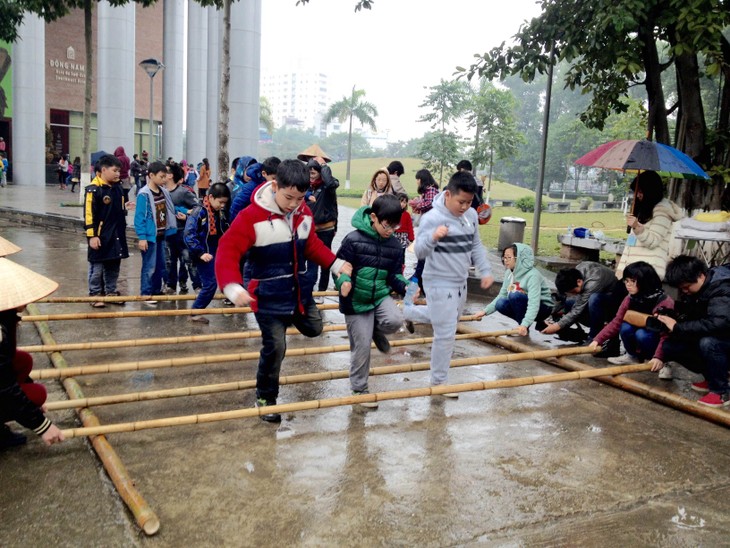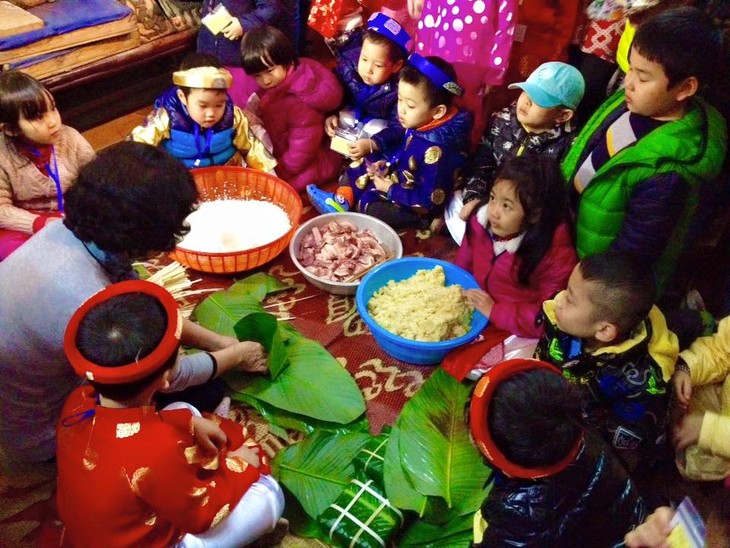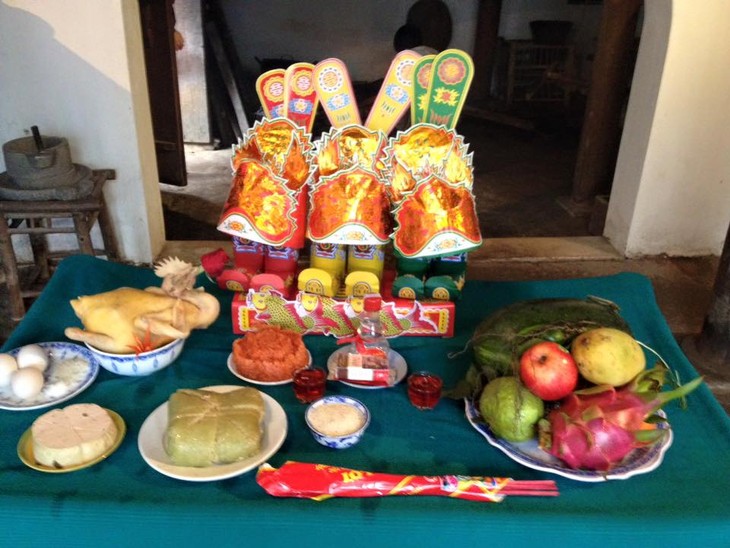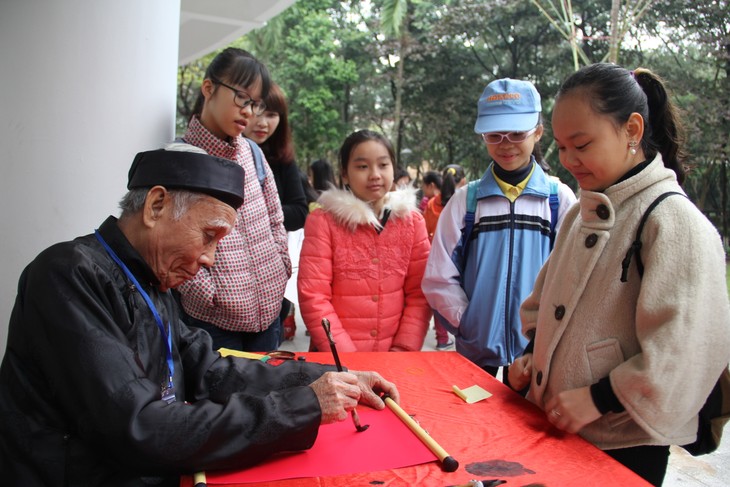(VOVworld) - Folk games such as bamboo dance, tug of war, mud banger, and stilt walking, were recreated in a program called “Discovering Vietnamese Tet” at the Vietnam Museum of Ethnology on January 30. Participants had an opportunity to learn how to make a Chung (square sticky rice) cake, watch artisans make To He (tiny clay) figurines, and enjoy a water puppet show. Many distinctive features of Vietnamese Tet were represented in this program.
Vietnamese bamboo dance is said to be the easiest game of all to play. Originally from Vietnam’s northwestern mountains, bamboo dance is performed during special events like Tet. People hold two sticks of bamboo and clap them together in a 4/4 rhythm while other people dance in and out of the sticks. The familiar melody of the game is traditional music of the Thai ethnic people. Today’s participants include children from primary and secondary schools in Hanoi. A group of secondary students seemed to really enjoy the game. They never missed a beat. 11-year-old Le Truc Quynh, a student at Chu Van An primary school, had this to say: I’ve tried this bamboo dance. It’s really fun and it helps me and my friends feel closer to each other. This game is easy and I learnt it very quickly.
 |
| Vietnamese bamboo dance |
Another group of pupils are playing tug of war, a Vietnamese folk game honored by UNESCO as an Intangible Cultural Heritage of Humanity.They were split into two teams, the boys against the girls. The girls won.
Mud banger was a game very familiar to children in the old days. All you need to play mud banger is mud. The game is simple. You just need to shape the mud like a boat, then throw it on the ground. If the mud banger makes an explosive sound, you win. If not, you lose.
23-year-old Le Thanh Son from the Hanoi University of Mining and Geology said: It’s really hard to make a mud banger. I observed the technique for 2 hours but when I tried it, I found it was harder than it looked. You have to shape the mud and make sure it is even. This requires a strong hand and meticulousness. It has to be done carefully. I just made one and the result was not so good. When I threw it on the ground, it didn’t make a sound.
Other children are learning how to make a Chung (square sticky rice) cake. Artisan Nguyễn Thanh of Phu Dien district, Tu Liem, Hanoi, is teaching the kids how to make the cakes. She said: On green leaves, we put a layer of sticky rice and a layer of crushed green beans. Next we have a layer of pork, followed by another layer of green beans, and finally another layer of sticky rice. Now we can start folding and wrapping the cake. After that, we boil the cakes. It takes about 8-10 hours to boil big cakes and 5-6 hours to boil small cakes. The most difficult part of making a Chung cake is the wrapping technique. If you’re not careful, the filling will ooze out of the cake, making it turn sour and it can’t be kept for a long time. You must make sure that the pork and green bean layers are covered by the rice layers.
 |
| An artisan is showing children how to make Chung or square sticky rice cake. |
Hoang Ngoc Chau, a pupil from Chu Van An primary school, finally finished her own hand- made Chung cake. Holding the cake in her hand, she happily shared with us:
I feel really excited and happy. I was taught how to make a Chung cake by the female artisan. This is the first time I’ve made one. I can see that mine doesn’t look too perfect, but I’m still happy with the result. I’m going to give this Chung cake to my grandparent as a gift.
Second-grader Nguyen Phuong Khanh Vi, a pupil at Tay Son primary school, said: Attending the “Discovering Vietnamese Tet” program at the Vietnam Museum of Ethnology today, I loved the To He and Chung cake activities the most. I made one Chung cake and I think the most difficult part is using your hands to push hard on the cake to wrap it. I saw my friends make Chung cakes and I learned from them. I love Vietnamese Tet, which is really fun and is all about family re-unions.
 |
| The Kitchen God worshiping ritual. |
The Kitchen God worshiping ritual, another tradition of Vietnamese Tet, was also showcased today. Some children were really fascinated by the altar used in Kitchen God worshipping. Pham Hai Yen Ngoc, an 11 year old attending Chu Van An primary school, said: As far as I know, this is the Kitchen God worshiping ritual. These fish on the water pot are for the Deities to ride on their way to heaven. They will bless our family and carry our wishes for a happy new year.
Even the older students seemed fascinated by these activities. 20 year old Hoang Huong Quynh said: Tet at the Vietnam Museum of Ethnology is totally different from Tet in daily life today, when people seem to have forgetten about traditional folk games, calligraphy, and Dong Ho folk paintings. The museum has restored these traditions and shared them with today’s audience. I feel like I’ve revisited some childhood memories. When Tet approached, my parents always bought me To He and I had a chance to watch the making of Chung cakes, though I did not make any. I can also see now how the Kitchen God worshipping ritual is done. I know that the meaning of this ritual is to let go of the past and welcome the new luck and happiness of the New Year.
Diana Taylor, a visitor from the US, said: I’ve been over by the painting and saw the painting being done, which was really cool. And we just came over here to make Chung cake. I’ve been living in Hanoi for 4 months and have not yet seen a water puppet show, I have to go see it.
In a small pool at another venue of the event, a water puppet show is being performed. A traditional Vietnamese orchestra which provides a musical accompaniment sits on the left hand side of the pool. The instrumentation includes vocals, drums, wooden bells, cymbals, horns, gongs, and several other traditional instruments. The puppets enter from either side of the stage, or emerge from the murky depths of the water. They recreat some of the most classical water puppet plays. In the audience is 22-year-old Doan Quoc Cuong, who said: This is the first time I’ve watched a water puppet show and I have many reactions. I wonder how the puppets are made to move. Puppeteers who hide themselves behind that bamboo curtain must lay their body under the water and it’s really cold. I’m impressed by this type of Vietnamese traditional water puppet performance. In my mind, water puppetry is very simple. Now that I’ve had a chance to see the show, I can see that it takes a lot of skill to control the puppets so that they coordinate with the music.
At another venue, some people are trying the stilt walking game. With the help of a museum’s volunteer, even children can master this game. 11-year-old Do Hong Thuy said: Today, I’ve had a chance to learn about calligraphy, make Chung cake, and play the stilt walking game. It’s the first time I’ve tried stilt walking but after being instructed for only 5 minutes, I now can walk steadily. I want to tell people who don’t know how to play that with some effort they can do it.
 |
| A small customer is eager to watch calligrapher writing calligraphy. |
Le Tuan, a volunteer who was really happy about teaching the kids to play traditional games, said: Children got a chance to participate in the museum’s activities and also received gifts. I’m happy to be a volunteer and get to play with the kids. To me, the program is a great chance to learn about Vietnamese traditions. When I was small, I didn’t have many chances to participate in traditional folk games like these.
 |
| Artisan is introducing about Dong Ho folk painting. |
Traditional calligraphy and Dong Ho folk paintings are also on display at the museum. Young Vietnamese are getting a chance to participate in a number of other folk games which do not regularly appear in modern life: Còn throwing, grapefruit throwing, and bamboo swinging. Through this program, they learn more about Vietnamese Tet traditions.